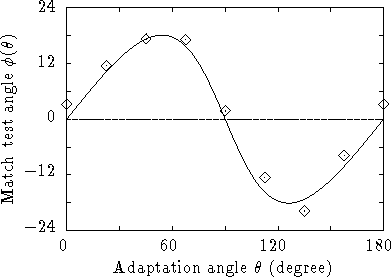


Next: References
Up: Appendix
Previous: Linear First Order
Webster and Mollon [21] did some experiments recently on
changes in colour appearance following post-receptoral adaptation. The
color in the cortex is represented by two statistically independent
channels which in our case corresponding to the two neurons. After
adaptation to a color hue of angle  , the appearance of the color
hue at
, the appearance of the color
hue at  is changed. They measured explicitly the angle of the
appearing color hue rotated rotated from the real one (
is changed. They measured explicitly the angle of the
appearing color hue rotated rotated from the real one ( ). In
Figure 7, the theory (Equation 20) and the
experiment data are compared. It is amazing to see how well the theory
matched the experiments given that the theoretical curve has only one
parameter.
). In
Figure 7, the theory (Equation 20) and the
experiment data are compared. It is amazing to see how well the theory
matched the experiments given that the theoretical curve has only one
parameter.

Figure 7:
Comparison with experiment for color adaptation of human vision. The
diamond symbols are the experimental data. The theoretical curve (solid
line) has only one parameter  which is the strength of
decorrelation feedback.
which is the strength of
decorrelation feedback.
The same equation is also derived by Atick et al. [1],
although they also used decorrelation, but like Linsker [16,17],
their approach emphaseses feedforward path rather than feedback path.
Our theory of visual cortex emphaseses the function and adaptation of
the connections within cortex. As is shown in the paper that our theory
not only predict the simple color adaptation result but also predict the
effects of orientation illusions.



Next: References
Up: Appendix
Previous: Linear First Order
 , the appearance of the color
hue at
, the appearance of the color
hue at  is changed. They measured explicitly the angle of the
appearing color hue rotated rotated from the real one (
is changed. They measured explicitly the angle of the
appearing color hue rotated rotated from the real one ( ). In
Figure 7, the theory (Equation 20) and the
experiment data are compared. It is amazing to see how well the theory
matched the experiments given that the theoretical curve has only one
parameter.
). In
Figure 7, the theory (Equation 20) and the
experiment data are compared. It is amazing to see how well the theory
matched the experiments given that the theoretical curve has only one
parameter.




 which is the strength of
decorrelation feedback.
which is the strength of
decorrelation feedback.